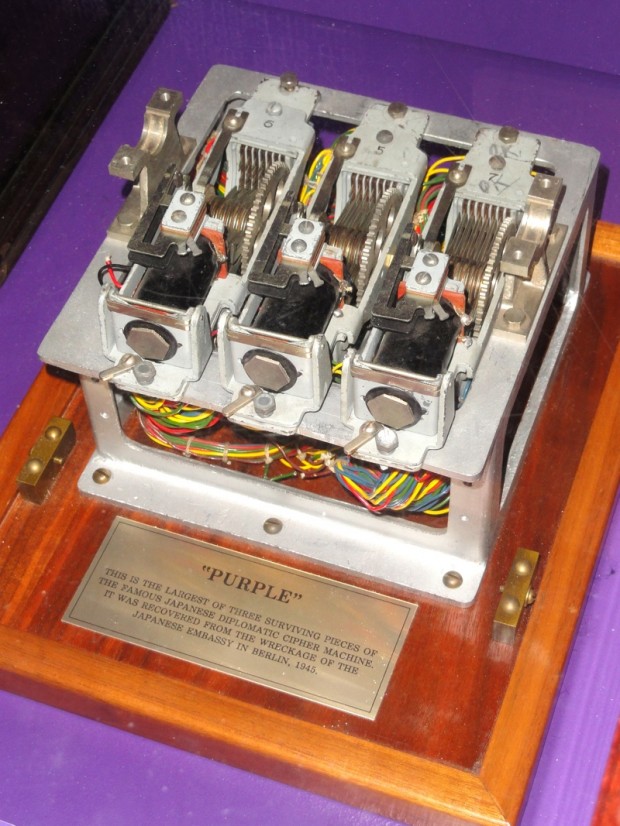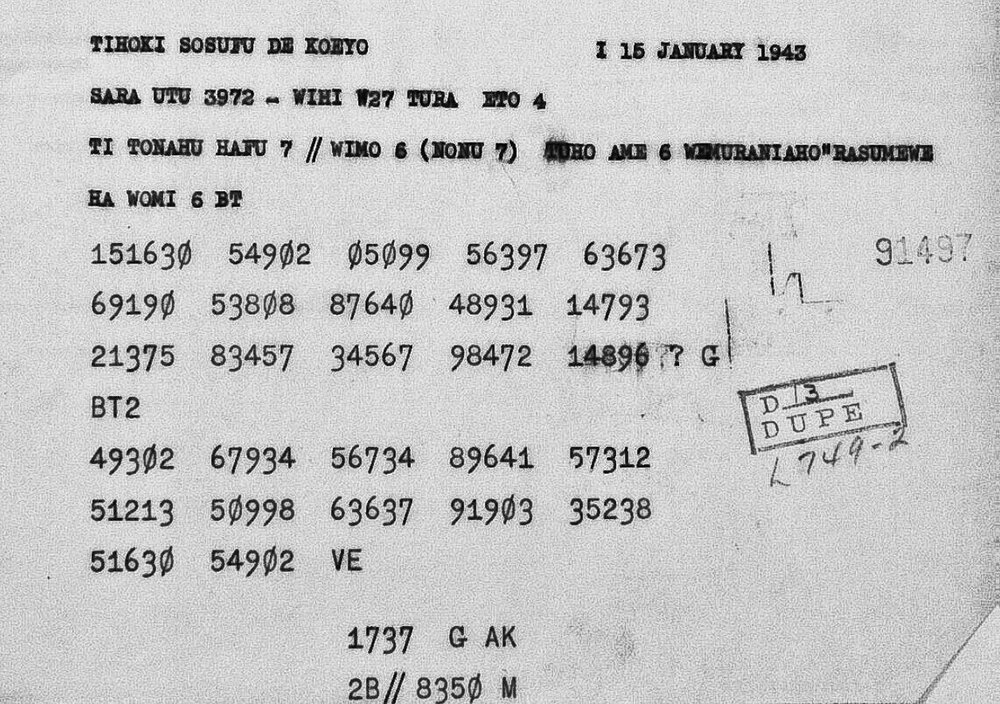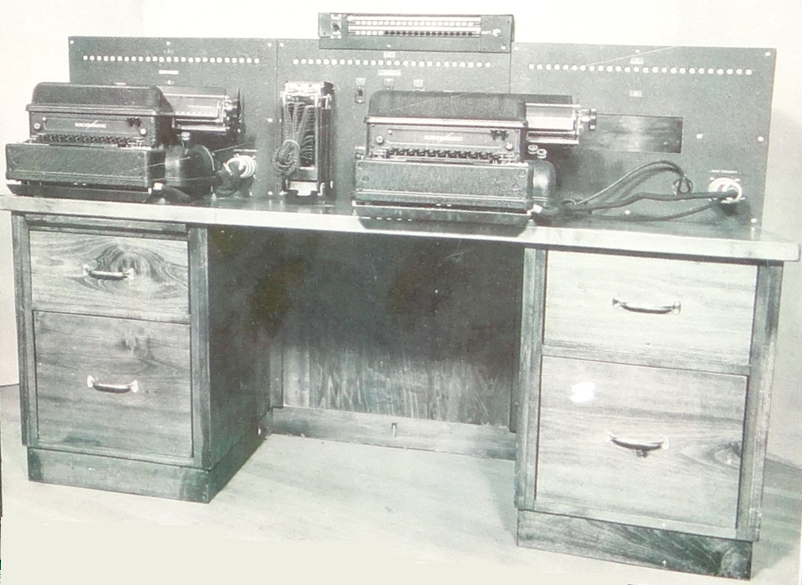The Battle of Coral Sea: The Importance
of Military Intelligence in the Pacific Theater
PDF Version
1st Lt. Brendan H.J. Donnelly, USAF | Oct 10 th 2022
“It was in the Battle of the Coral Sea that signals
intelligence came of age, demonstrating its capacity to predict the enemy’s
intentions will in advance and with remarkable accuracy”. Craig Collie, 2017.

The Pacific Theater in World War II presents dozens of
battles both on land and sea that can be studied to identify tactics and
lessons to be learned. One such battle is that of Coral Sea, the first aircraft
carrier battle that was the pre-courser to the Battle of Midway. The Battle of
Coral Sea is still one that can be shown as an example of how sea-based
aircraft should be used in war, but the battle is also a prime example for how
intelligence can impact a war effort and how multinational coalitions with both
military equipment and intelligence sharing are necessary for war in the 21st
century. Coral Sea was one of many battles that identified how Signals
Intelligence (SIGINT) could be used during war time which assisted in the
creation of the NSA in 1947. Yet during the war the predecessor for SIGINT was
Radio Intelligence (RADINT) which would impact the entire theater drastically
in conjunction with the use of airborne reconnaissance. The use of RADINT and
airborne assets to conduct reconnaissance missions would be two of the most
important new combination of capabilities in the Battle of Coral Sea.
Overview of Coral Sea
Coral Sea as a battle requires multiple
stages in order to understand the full picture. Before
the aircraft carriers even met there are significant actions that took place
that provide lessons to be learned outside of the main engagement. The first of
these includes what happened before the aircraft carriers were even at Coral
Sea, namely what did the intelligence provide. Before the battle at Coral Sea
the Japanese were using two primary encryption codes that the United States
named “Purple” (the successor to “Red”) and the more complicated of the codes
JN25. All of these codes the United States was able to
break allowing for almost immediate decryption of Japanese troop movements,
political intent, military intent and the movement of military officials. By
breaking JN25 the United States and the allied nations became aware of the
intent for the Japanese to send a naval force in the southern Pacific.[i]
Admiral Nimitz the Commander in Chief of the Pacific Fleet sent additional
ground-based surveillance and reconnaissance aircraft as well as two aircraft
carriers, the USS Lexington and the USS
Yorktown. The intelligence that was provided gave indications and warnings
of Japanese offensive intent in a timely manner allowing pre-positioning of
forces. This is a key example of how intelligence used at the right time can
permit the use of assets at the right place.

The original plan for the Japanese was
to take control of Port Moresby so that supply lines between the U.S. and
Australia could be cut and for Japanese troops to be positioned here to support
future offensive action against Samoa and New Caledonia. During the first
phases of the Japanese plan of action aircraft were needed to support Rabaul, and Tulagi needed to be secured. On 2 May the main
Japanese carrier force sent fighter aircraft to Rabaul
but due to weather this was delayed until 4 May delaying the main force two
days. During this delay Tulagi was secured on 3 May, the USS Yorktown was
alerted already of the attack on Tulagi and sent a raid resulting in one
destroyer and three minesweepers sunk, one destroyer and one minesweeper
damaged to include 87 men killed.[ii]
The USS Yorktown after the raid returns to meet the USS Lexington,
while the main Japanese force arrives around Tulagi unable to counter the U.S.
attack. On 7 May the U.S. carrier group and the Japanese carrier group both
launch air raids on false targets. The U.S. spots the Japanese light carrier
the HIJMS Shoho south of Misima
Island and sinks it. While the Japanese report the U.S. carrier group but
instead find the USS Sims and the USS Neosho a destroyer and
oiler that are attacked with the USS Sims being sunk and the USS
Neosho badly damaged having to return for repairs.[iii]
Then on 8 May the main Japanese and U.S. carrier forces battle using aircraft
only, being the first aircraft carrier battle. Almost simultaneously the U.S.
launches 75 planes while the Japanese launch 69 planes.[iv]
After the engagements the result stands at the HIJMS Shokaku
having to leave due to damages and the HIJMS Zuikaku
having to follow, effectively taking two of the six Japanese carriers out
of play for the upcoming battle at Midway. Additionally, the Japanese
throughout the battle lost the HIJMS Kikuzuki,
three auxiliary vessels, 77 planes, 90 aircrew and 1,074 men.[v] For the allies during the battle the USS
Lexington was sunk in addition to the USS Sims and USS Neosho.[vi]
As for aircraft the U.S. also lost 66 aircraft, 35 aircrew and a total of 543
men during the battle.[vii]
When totaled by tonnage the Japanese come out of this engagement victorious,
but in the strategic realm the removal of two aircraft carriers from the
Japanese fleet at Midway was a large victory for the allies.
When considering the battle’s tactics
and the information from both sides we now know, two intelligence aspects stand
out, these being airborne reconnaissance and SIGINT. In addition to the
bombers, fighter aircraft, and aircraft carriers, key support to the Allies
came from the intelligence that was collected. Would the battle even have
occurred if not for the decrypted signals in the joint effort between the
United States, British and Australian signal corps? Additionally, would the
Japanese had the upper hand if they started to use
sea-based air reconnaissance earlier to detect the U.S. task force? These
questions we may never truly answer but the impacts of the airborne
intelligence and SIGINT are clear.
Airborne Reconnaissance
Aside from the dive bombers, fighters
and torpedo bombers used during the offensive stages of Coral Sea, airborne
reconnaissance aircraft played a significant part in the battle as well.
Without reconnaissance aircraft both the allies and the Japanese would have
relied on radar which at the time was not a robust and reliable system, or by
relying on counter-attacks based on where the enemy aircraft came from. The
importance of reconnaissance aircraft was understood by both sides by the
importance was better understood by the U.S. since reconnaissance aircraft were
used either by land based or sea-based take-off and landing. This is unlike the
Japanese that relied on land-based reconnaissance aircraft. This critical
difference in tactics significantly assisted the ally’s sine land-based aircraft
were restricted by a definite range before having to return for fuel, while sea-based
aircraft had shorter range but were extended by the landing strip being out in
the sea.
The lesson is clear to the observer
that reconnaissance aircraft are critical when trying to identify the location
of the enemy, but truly this lesson is highlighted more in the present day
since aircraft Intelligence, Surveillance and Reconnaissance (ISR) capabilities
are more robust then during Coral Sea. Tactical ISR aircraft that are launched
from aircraft carriers today are now more important than ever since indications
and warnings to protect the fleet including support vessels, carriers, destroyers and amphibious vessels is the top priority. That
being said the combination of the Japanese and allied tactics is how in the 21st
Century a campaign needs to run, the joint use of land based
and sea based ISR from the Philippines, Australia, New Zealand and the
surrounding islands provides overlapping reconnaissance coverage. This is
necessary to maintain maritime surface and sub-surface surveillance so that the
element of surprise is null and void.
The U.S. and Australian Signals
Intelligence

Signals Intelligence in the 21st
Century is now one of the most complicated ways of collecting and countering
the collection of data. Although, the Battle of Coral Sea is an example for how
at the time RADINT the predecessor of SIGINT can drastically impact the battlefield.
Without the decryption of the JN25, Red and Purple codes used by the Japanese
who knows what could have happened to Port Moresby and the southern Pacific
during the war. Yet, the decryption was made possible by the U.S. Signals
Intelligence Service (SIS), British decryption out of Bletchley Park, the
Australian Signal Corps and New Zealand Signal Corps. Between the four nations
the Special Intelligence Bureau was created to share the intercepted Japanese
messages that each country was collecting.[viii]
The difference with the Japanese codes compared to the German codes was that
Enigma the German cipher machine was used to encrypt codes. The Japanese
instead for their JN-25 code it included an encrypted codebook for diplomatic
messages.[ix]
The codes were then additionally re-encrypted a second time with another code
book with the second set of codes using ‘false’ numbers so that the receiving
member would have to use a correlating additive table to reveal the underlying
codes message.[x] Cryptologists
and mathematicians from each country joined with military organizations to
break the JN25 code after the Red and Purple codes had already been broken. This
amount of assistance was necessary since with the double encryption, without
the additive aid, the code breakers would have to break the first cipher then
the messages themselves.[xi]
Although at first initial efforts to break the code were unsuccessful
decrypting operational messages the U.S. and the British were able to keep
track of Japanese navy allowing them to monitor the order of battle in the
theater.[xii]
Later in the effort to break the JN25 code other messages were able to be
decrypted indicating the Japanese intent to spread its empire to the south-east
of the Pacific, this allowing the allies to build up additional forces to
combat the Japanese expansion.[xiii]
As there was an increase in radio traffic, the Australian and U.S. Navy SIS was
able to identify “numerous indications which point to an impending offensive
from Rabaul base”.[xiv]
This intelligence was enough for the U.S. to then place additional assets in
the south Pacific which we know now as what turned up to be the battle at Coral
Sea. The combined effort between the
four nations is the lesson in itself that not only
SIGINT but shared intelligence between the nations is critical in order to
affect the war effort; “It was in the Battle of the Coral Sea that signals
intelligence came of age, demonstrating its capacity to predict the enemy’s
intentions will in advance and with remarkable accuracy”.[xv]
Applications for the 21st
Century Pacific Theater
To apply the Battle of Coral Sea to the
Indo-Pacific region in the 21st century one of the most critical
lessons is that the United States and their allies must maintain
multi-dimensional intelligence collection capabilities. In World War II
collection capabilities relied on RADINT and reconnaissance aircraft flights
but now the United States and the other allied countries have significant
upgrades in technology, but the lesson stands true. For the 21st
century upgrading and maintaining a robust SIGINT network that can be shared
between the allied countries will allow for indications and warnings of
potential Chinese or other actors intentions. To compliment this a stress on space-based
collection capabilities namely satellites is a field that has been forgotten
but is one of the most significant players in the theater. Having a dominant
presence in space is what will ensure that the United States has intelligence
collection capabilities in their “back pocket” that many other countries in the
world do not have. Lastly, placing sufficient airborne ISR aircraft in the
theater will allow for an overlap and extension of collection capabilities.
Aircraft such as the MQ-9, U-2, RQ-4, RC-135 and many more robust collection
capabilities need to be massed around the high interest area in
order to best support war planning and provide additional intelligence
collection to inform military leaders and policy makers.
Signals Intelligence also impact today
in that the United States has a vast amount of military power but, without
SIGINT and information sharing data between New Zealand, Australia, Japan,
South Korea, the United Kingdom, and the Philippines serious consequences may
ensue. It is crucial to share information since all of
these nations have a part to play in a conflict against the primary aggressor
in the area of operation, China. Like before the Battle of Coral Sea the
nations working together to break the Japanese codes, having overlapping, and
robust SIGINT collection networks in the theater and
sharing the information may provide Chinese intent, military actions and
potential expansion or planning in the area.
Not only does the United States and its
allies need ISR but ensuring a presence of overlapping and sophisticated
defensive systems will ensure the survival of the forces already in the
theater. One of the more significant tactics during the Battle of Coral Sea
that the United States used was having the aircraft carriers close enough to
the other destroyers and support ships that all anti-aircraft guns could
support the effort. This same principle is needed in a new age conflict of
having counter ballistic missile systems, anti-aircraft systems,
anti-submarine, and counter-surface warfare capabilities. Employing these types
of overlapping defenses will increase the number of remaining forces if a
surprise attack or devastating blow from advanced technology occurs at the
start of a major conflict. Furthering this effort, the burden does not only
need to rely on the U.S. military but using multi-nation partnerships and
defenses will also assist in large conflict in the Indo-Pacific.
Conclusion
Overall, the Battle of Coral Sea as the
first aircraft carrier battle in history holds many stories to be told, and
each one of them providing an essential lesson that fundamentally can impact
warfare today. Studying the tactics conducted by the United States and the
Japanese during the battle and applying them today can assist in the war
planning and shaping the mentality that is required for large scale conflict in
the largest geographic theater on the planet. Such lessons like using and
maintaining a robust SIGINT network, defensive network and a combined
multi-national partnership may not prevent a war, but if a conflict were to
arise the allied powers would be significantly more prepared by learning from
previous engagements in the theater.
Author
Biography: 1st
Lt Brendan H.J. Donnelly, USAF
Lieutenant Donnelly is an intelligence
officer stationed at Cannon AFB, NM. He has held intelligence supervisor roles
at Cannon AFB and Special Operations Forces Africa. He graduated Bowling Green
State University, with a Bachelor of Arts of Sciences, majoring in History.
References
[i]
Smith, Michael, The Emperor’s Codes: The Thrilling Story of the Allied Code
Breakers Who Turned the Tide of World War II, Arcade Publishing, (2000).
[ii] Montemayor,
“The Battle of the Coral Sea 1942: The First Aircraft Carrier Battle in
History” YouTube (June 26, 2018), https://www.youtube.com/watch?v=NB5hH3ksvKE.
[iii] Stille, Mark, The Coral Sea 1942, Osprey Publishing
(2009), pg 9.
[iv] Stille, The Coral Sea 1942, pg
10.
[v] Montemayor.
[vi] Montemayor.
[vii] Montemayor.
[viii]
Smith, pg 80.
[ix] Collie,
Craig, Code Breakers, Allen & Unwin (2017), chp
6 pg 117.
[x]
Collie, Code Breakers, pg 117.
[xi] Collie,
Code Breakers, pg 117.
[xii] Smith,
pg 84.
[xiii]
Smith, pg 88.
[xiv] Collie,
Code Breakers, pg 120.
[xv]
Collie, Code Breakers, pg 133.